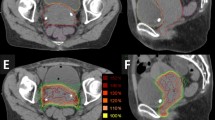Abstract.
Excellent local control rates of interstitial brachytherapy in oral cavity cancer and oropharyngeal carcinoma have been demonstrated in different retrospective studies. Compared to external-beam radiation therapy the high local control rates with a low rate of side effects obtained by interstitial brachytherapy are the result of a steep dose reduction in the implant-surrounding normal tissues. Therefore, interstitial brachytherapy offers rather the possibility to give high doses without inevitably leading to high complication rates. Low-dose-rate (LDR) and pulsed-dose-rate (PDR) interstitial brachytherapy with 0.4–0.55 Gy/h/24 h for tumors of the oral cavity and oropharynx in selected patients is a proven, effective and safe treatment method with excellent long-term data both as a sole treatment modality and a postoperative method, as well as a unique treatment method of head and neck tumors in previously irradiated areas. This paper deals with the technical aspects of interstitial brachytherapy, that seem to be relevant to high-quality outcome, and gives an overview of indications as well as past and recent results of interstitial brachytherapy in head and neck cancer.
Zusammenfassung.
In einer ganzen Reihe von retrospektiven Studien wurden ausgezeichnete lokale Kontrollraten der interstitiellen Brachytherapie bei Karzinomen der Mundhöhle und des Oropharynx demonstriert. Im Vergleich zur perkutanen Bestrahlung sind die hohen lokalen Kontrollraten der interstitiellen Brachytherapie mit geringeren Nebenwirkungen ein Ergebnis der steilen Dosisreduktion in dem das Implantat umgebenden Gewebe. Aus diesem Grund ermöglicht die interstitielle Brachytherapie die Verabreichung hoher Dosen, ohne dass zwangsläufig schwere Nebenwirkungen entstehen. Die interstitielle Low-Dose-Rate-(LDR-) und Pulsed-Dose-Rate- (PDR-)Brachytherapie mit 0,4–0,55 Gy/h/24 h bei ausgewählten Patienten mit Mundhöhlen- und Oropharynxkarzinomen ist eine bewährte, effektive und sichere Methode mit ausgezeichneten Langzeitergebnissen, sowohl als alleinige Behandlungsmethode als auch als postoperative Therapie und ebenfalls als eine einzigartige Behandlungsmethode von vorbestrahlten Hals-Nasen-Ohren-(HNO-)Tumoren. Dieser Beitrag befasst sich mit technischen Aspekten der interstitiellen Brachytherapie, die für die hohe Qualität der Behandlungsergebnisse relevant sind, und gibt eine Übersicht über Indikationen und aktuelle Ergebnisse der interstitiellen Brachytherapie bei HNO-Tumoren.
Similar content being viewed by others
Author information
Authors and Affiliations
Corresponding author
Additional information
This paper is dedicated to Professor Rolf Sauer, MD, chair of the Department of Radiation Oncology, University of Erlangen, on the occasion of his 65th birthday.
Rights and permissions
About this article
Cite this article
Strnad, V. Treatment of Oral Cavity and Oropharyngeal Cancer. Strahlenther Onkol 180, 710–717 (2004). https://doi.org/10.1007/s00066-004-9196-x
Issue Date:
DOI: https://doi.org/10.1007/s00066-004-9196-x




